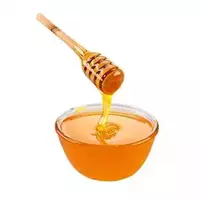Paddy honey

When the amount of flower nectar for some reason decreases significantly or is absent at all, bee workers begin to collect paddy - sweet secretions of insects or plants. The resulting product is therefore called paddy honey, which is produced from this paddy. By the way, there are many legends about the useful properties of paddy honey, and besides, in Europe it is valued much higher than its floral counterpart.
Basically, paddy honey can have a color characteristic of a bee product - yellow-orange, although sometimes such honey is of perfect, not attractive color. For example, there is dark green paddy honey or almost black in general - the color is due to a lot of factors. Paddy honey is characterized by increased density and density, while it has a moderate sweetness with a slightly bitter taste. The faint aroma of paddy honey is largely different from the usual honey from floral nectar.
By the way, paddy honey collected from deciduous tree species turns out to be very dark, brown with a greenish tint, conifers give a lighter tint with pronounced greenery. Honey from mixed forests resembles tar in color and structure. But it is almost unrealistic to meet pure carrion honey, since it always contains a share of flower honey. Any type of paddy honey is non-resistant, very hygroscopic and therefore can fade quickly.
Composition of paddy honey
Paddy honey can be applied for culinary purposes, but most people find it more reasonable to use this wonderful product to treat and promote health. This is due to the fact that when heated, the mass of beneficial properties of paddy honey simply evaporates.
And there is something to "boast" of this gift of nature: compared to ordinary honey, paddy honey contains three and a half times more floral nitrogenous protein substances, as well as salts of iron, manganese, phosphorus and cobalt. In addition, the amount of phytoncides in it is
1. 7 times higher, and these substances have a natural antibiotic effect. Paddy honey from wooded highlands, as well as mixed coniferous-deciduous forests, is considered especially valuable.
It is worth noting that all sources of paddy honey can be divided into animals (bears, aphids, worms, foliage) and plant (stems and leaves). Animal carrion has different properties than plant raw materials - it contains a considerable amount of protein compounds, as well as mineral acids and salts, which are integral components in the composition of carrion honey.
paddy honey 328 kCal
Energy value of paddy honey (Ratio of proteins, fats, carbohydrates - ju):
Proteins: 0.8 g (~ 3 kCal)
Fats: 0 g (~ 0 kCal)
Carbohydrates: 80.3 g (~ 321 kCal)
Energy ratio (bj | y): 1% | 0% | 98%
 Español
Español Français
Français Português
Português Русский
Русский 简体中文
简体中文 繁體中文
繁體中文 日本語
日本語 한국어
한국어 العربية
العربية Türkçe
Türkçe Қазақ
Қазақ Deutsch
Deutsch Italiano
Italiano Українська
Українська
